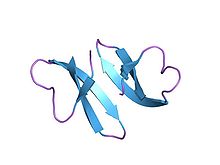- Alpha defensin
-
Mammalian defensin 
Structure of defensin HNP-3.[1] Identifiers Symbol Defensin_1 Pfam PF00323 InterPro IPR006081 PROSITE PDOC00242 SCOP 1dfn TCDB 1.C.19 OPM family 56 OPM protein 1tv0 Available protein structures: Pfam structures PDB RCSB PDB; PDBe PDBsum structure summary Alpha defensins are a family of mammalian defensin peptides.
Defensins are 2-6 kDa, cationic, microbicidal peptides active against many Gram-negative and Gram-positive bacteria, fungi, and enveloped viruses,[2] containing three pairs of intramolecular disulfide bonds. On the basis of their size and pattern of disulfide bonding, mammalian defensins are classified into alpha, beta and theta categories. Alpha-defensins, which have been identified in humans, monkeys and several rodent species, are particularly abundant in neutrophils, certain macrophage populations and Paneth cells of the small intestine.
Defensins are produced constitutively and/or in response to microbial products or proinflammatory cytokines. Some defensins are also called corticostatins (CS) because they inhibit corticotropin-stimulated corticosteroid production. The mechanism(s) by which microorganisms are killed and/or inactivated by defensins is not understood completely. However, it is generally believed that killing is a consequence of disruption of the microbial membrane. The polar topology of defensins, with spatially separated charged and hydrophobic regions, allows them to insert themselves into the phospholipid membranes so that their hydrophobic regions are buried within the lipid membrane interior and their charged (mostly cationic) regions interact with anionic phospholipid head groups and water. Subsequently, some defensins can aggregate to form 'channel-like' pores; other s might bind to and cover the microbial membrane in a 'carpet-like' manner. The net outcome is the disruption of membrane integrity and function, which ultimately leads to the lysis of microorganisms. Some defensins are synthesized as propeptides which may be relevant to this process.
Human defensins
Initially human alpha defensin peptides were isolated from the neutrophils and are thus called human neutrophil peptides.[3] Human neutrophil peptides are also known as α-defensins.
Sequences of major human α-defensins:[4]
Gene Aliases Peptide Sequence DEFA1 HNP1 human neutrophil peptide 1 ACYCRIPACIAGERRYGTCIYQGRLWAFCC HNP2 human neutrophil peptide 2 CYCRIPACIAGERRYGTCIYQGRLWAFCC DEFA3 HNP3 human neutrophil peptide 3 DCYCRIPACIAGERRYGTCIYQGRLWAFCC DEFA4 HNP4 human neutrophil peptide 4 VCSCRLVFCRRTELRVGNCLIGGVSFTYCCTRV DEFA5 HD5 human defensin 5 ATCYCRHGRCATRESLSGVCEISGRLYRLCCR DEFA6 HD5 human defensin 6 AFTCHCRRSCYSTEYSYGTCTVMGINHRFCCL HNP-1, HNP-2 and HNP-3 are encoded by two genes DEFA1 and DEFA3 localized at chromosome 8, location 8p23.1. DEFA1 and DEFA3 encode identical peptides except the conversion of the first amino acid from alanine in HNP-1 to aspartic acid in HNP-3; HNP-2 is an N-terminally truncated iso-form lacking the first amino acid. Human neutrophil peptides are found in human atherosclerotic arteries, inhibit LDL metabolism and fibrinolysis and promote Lp(a) binding.[5]
Human neutrophil-derived alpha-defensins (HNPs) are capable of enhancing phagocytosis by mouse macrophages. HNP1-3 have been reported to increase the production of tumor necrosis factor (TNF) and IL-1, while decreasing the production of IL-10 by monocytes. Increased levels of proinflammatory factors (e.g., IL-1, TNF, histamine and prostaglandin D2) and suppressed levels of IL-10 at the site of microbial infection are likely to amplify local inflammatory responses. This might be further reinforced by the capacity of some human and rabbit alpha-defensins to inhibit the production of immunosuppressive glucocorticoids by competing for the binding of adrenocorticotropic hormone to its receptor. Moreover, human alpha-defensins can enhance or suppress the activation of the classical pathway of complement in vitro by binding to solid-phase or fluid-phase complement C1q, respectively. The capacity of defensins to enhance phagocytosis, promote neutrophil recruitment, enhance the production of proinflammatory cytokines, suppress anti-inflammatory mediators and regulate complement activation argues that defensins upregulate innate host inflammatory defenses against microbial invasion.
In one small study, a significant increase in alpha-defensin levels was detected in T cell lysates of schizophrenia patients; in discordant twin pairs, unaffected twins also had an increase, although not as high as that of their ill siblings.[6]
References
- ^ Hill CP, Yee J, Selsted ME, Eisenberg D (March 1991). "Crystal structure of defensin HNP-3, an amphiphilic dimer: mechanisms of membrane permeabilization". Science 251 (5000): 1481–5. doi:10.1126/science.2006422. PMID 2006422.
- ^ Selsted ME, White SH, Wimley WC (1995). "Structure, function, and membrane integration of defensins". Curr. Opin. Struct. Biol. 5 (4): 521–527. doi:10.1016/0959-440X(95)80038-7. PMID 8528769.
- ^ Ganz T, Selsted ME, Szklarek D, Harwig SS, Daher K, Bainton DF, Lehrer RI (Oct 1985). "Defensins. Natural peptide antibiotics of human neutrophils". J Clin Invest 76 (4): 1427–35. doi:10.1172/JCI112120. PMC 424093. PMID 2997278. http://www.pubmedcentral.nih.gov/articlerender.fcgi?tool=pmcentrez&artid=424093.
- ^ Bowdish D M E, Davidson D J, Hancock R E W (2006). "Immunomodulatory Properties of Defensins and Cathelicidins". CTMI 306: 27–66. PMID 16909917.
- ^ Nassar H, Lavi E, Akkawi S, Bdeir K, Heyman SN, Raghunath PN, Tomaszewski J, Higazi AA (Oct 2007). "alpha-Defensin: link between inflammation and atherosclerosis". Atherosclerosis 194 (2): 452–7. doi:10.1016/j.atherosclerosis.2006.08.046. PMID 16989837.
- ^ Craddock RM, Huang JT, Jackson E, et al. (March 2008). "Increased alpha defensins as a blood marker for schizophrenia susceptibility". Mol. Cell Proteomics 7 (7): 1204. doi:10.1074/mcp.M700459-MCP200. PMID 18349140. http://www.mcponline.org/cgi/pmidlookup?view=long&pmid=18349140.
Categories:- Protein domains
- Peripheral membrane proteins
Wikimedia Foundation. 2010.
